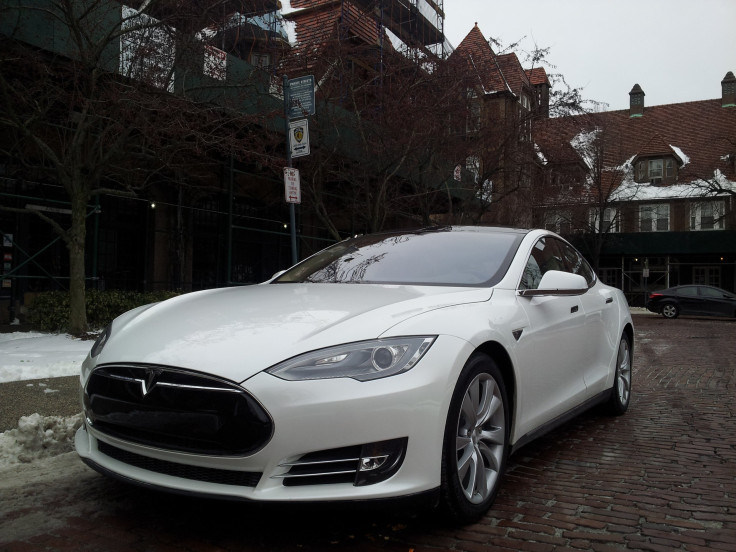Tesla Model S Road Test: What It's Really Like To Drive The 130 MPH Model S P85+

Only 20,000 of them were sold last year. Most of us have never even seen one.
The Tesla Model S just might be the most talked-about car on the planet right now, from an automaker that has shaken up the industry in recent years. The company’s founding genius, Elon Musk, is often compared to “Iron Man” hero-inventor Tony Stark, and the sleek car has attracted breathless headlines as well as some criticism for its speed and occasional battery fires.
But does it live up to the hype?
I found out on an overcast day at the end of January, when I was finally given a chance to take the new Tesla for a test drive.
As an auto columnist, I live and breathe cars – their horsepower, torque, all the new designs – and I have taken dozens of cars for test drives. But nothing like this.
On my way to Forest Hills, a residential neighborhood in Queens, N.Y., questions were flooding through my mind:
Would it look as cool as I imagined? Does it accelerate as fast as they say? Would the battery conk out on me? And, finally, what if I crashed it?
Finally, there it was.
In solid white, the Tesla Model S looked like a tamed jaguar, well-proportioned, a simple and effective execution of modern design. Lacking a conventional engine allows it to have a lower hood line for a sleek, sporty look. Among the curious details that stood out to me were the beautiful chrome door handles that sit flush with the body panel. The handles popped out only when I approached the car with the key fob.
Inside, the luxurious interior is a welcoming combination of soft leather, polished wood and bright aluminum trim. Overhead, a sensational panoramic glass roof gives it an airy feel.
The enormous 17-inch touchscreen display on the center console waterfall is the centerpiece of the Tesla Model S interior. The sharp display seamlessly integrates media, cabin control, vehicle data, phone connectivity and a GPS powered by Google Maps.
Finally, the 3G hotspot connectivity in the Model S brings together Tesla's interpretation of modern luxury. A Tesla app on your smartphone will allow you to control your car no matter where you are. The app not only lets you monitor its charge, but also enables you to turn on the climate control system, open or close the sunroof, and even locate the car on a map.
Now I was ready to roll. This model, the P85+, is the fastest and most powerful built by Tesla. It is capable of launching from 0 to 60 mph in just four seconds and will continue to accelerate until it reaches a top speed of 130.
Cruising through the streets -- oddly, I didn’t get any stares or looks from New Yorkers who seemed intent on going about their shopping – I was impressed with the speed. The staggering performance rivals sexier offerings like the 2014 Corvette Stingray.
But the similarities end there. While the Stingray's burly pushrod V8 bellows from its quad tail pipes, the electric motor of the Tesla Model S whispers a soft whine. If there's anything more shocking than the Tesla's ability to pick up speed, it is the silent masking of any sensation of just how fast I was traveling.
The Tesla Model S is not without fault. Another feature of the electric drivetrain is its regenerative braking system, which is designed to recharge the battery pack by harvesting heat extracted from the brakes and converting the kinetic energy back into electricity.
Although the idea is very clever, the system is rather disruptive in practice. Tesla's regenerative braking system will immediately grab the brakes to capture kinetic energy the moment the accelerator pedal is lifted. The abrupt transition is completely automatic, and a Tesla representative confirmed that the brake lights would go on even if my feet did not apply any pressure to the pedals. During my brief road test, I successfully slowed to a complete stop before a traffic light without ever applying my foot on the brake.
Thankfully, the Tesla rep explained that the system can be scaled. When coasting at highway speeds, the system can be switched to a low regenerative braking mode. At the "low" setting, the brake lights will not flash until the driver actually steps on the brake pedal.
The Tesla Model S is an electric car, but we are making a big mistake if we believe that is all it has to offer. Tesla's technical innovations begin at its electric drivetrain, but the bold company is pushing the envelope in luxury and performance as well.
Pricing for the Tesla Model S P85 starts at $87,070. To gain more technical insights, head over to iMotorTimes.
© Copyright IBTimes 2024. All rights reserved.




















